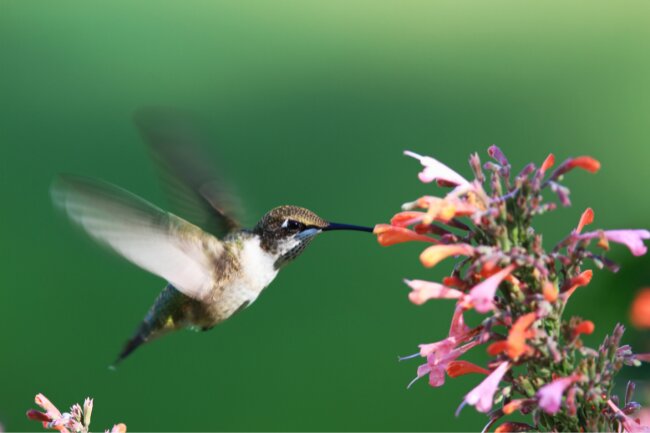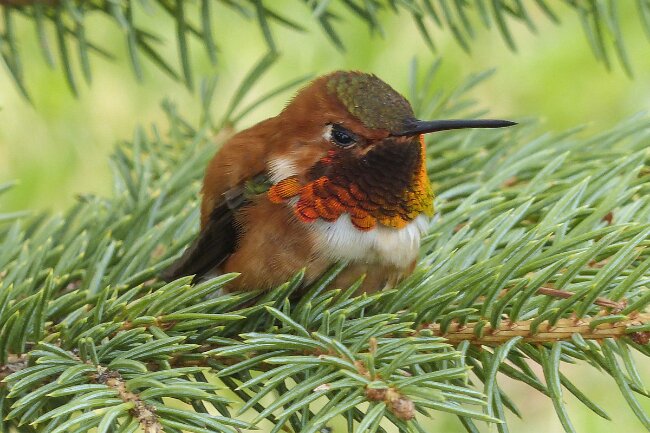Hummingbirds eat largely nectar and insects, however, they will take advantage of other sugar food sources at times, such as fruit juices and sap.
Contents
Sweet delight
For hummingbirds, there is one food that beats all others; nectar.
Nectar is a sweet liquid provided by flowers as a bribe to attract in animals to help move their pollen from one flower to another. This is known as pollination, while the animals that carry out the work are known as pollinators.
While pollen is the male reproductive offering, which will carry the flowers’ genes to a female counterpart to help produce young, nectar takes no part in the reproductive process. Nectar varies between flowers in quantity and quality, though the general make up stays fairly similar.
| Food Type | Description |
|---|---|
| Nectar | A sweet liquid made from sugar and water |
| Insects | Small insects and spiders that provide protein |
| Tree Sap | Sugary sap found in certain tree species |
| Pollen | Fine powder produced by flowers |
| Fruit Juice | Natural fruit juices, such as orange or grape |
Flowers are often looking to attract in particular species, and their shape and colour may therefore be more attractive to butterflies or beetles or even hummingbirds. Being designed for use by certain animals can help to ensure pollen is efficiently transferred, and increase the chances that species will visit a similar flower.
Flowers that have evolved to offer their nectar to hummingbirds tend to have a long, tubular shape. This shape can prevent many insect species from reaching the nectar, whereas a hummingbird’s long tongue allows it to reach in and slurp up the tasty reward.
Also read: Hummingbirds During the Winter… Migration Explained
What do hummingbirds eat besides nectar?
While nectar is a key food for hummingbirds, and the one they are most famous for enjoying, it’s not the only thing these little creatures need to survive.

Insects
Insects are one of the key foods for hummingbirds besides nectar. While nectar is a great source of sugars, it lacks many important proteins and minerals that these tiny creatures need.
A wide range of insects are eaten, from flies to spiders. Insects are a particularly significant food for chicks, as they require additional energy to grow.
Sap
The sap is eaten by a wide range of animal species, and hummingbirds will take advantage of fresh sap seeping from tree wounds. Sapsuckers often do the hard work exposing the sap, only to have hummingbirds sneak in and take a sip.
Fruit juice
While fruit is certainly too difficult for a hummingbird to swallow, they will certainly enjoy a sip of sugary juice oozing from over ripe or rotting fruit.
Ash and sand
Surprisingly, hummingbirds have been seen consuming small amounts of ash or sand. This isn’t unusual in the bird kingdom, with species like macaws eating lumps of clay. This kind of behaviour is usually to get hold of minerals and salts that are uncommon in their normal diet.
How do hummingbirds eat?

How hummingbirds eat depends on what they are eating. The iconic image is of course of these tiny birds hovering before a flower, their beaks dipped inside as they feed on the nectar.
| Flower Type | Description |
|---|---|
| Red Tubular Flowers | Attractive to hummingbirds due to their color and shape |
| Trumpet-Shaped Flowers | Flowers with a long, tubular shape and wide opening |
| Coral Honeysuckle | Fragrant flowers that produce nectar in abundance |
| Bee Balm | Brightly colored flowers that attract hummingbirds |
| Salvias | Showy flowers with tubular shape, available in various colors |
Hummingbirds are speedy in all they do, even how they eat. They can dip their tongue into the tasty nectar between 12 and 18 times per second, whilst feeding. Such rapid work is important as these birds require large amounts of nectar to keep them flitting through the air.
It used to be thought the nectar was picked up by their tongue by capillary action. Capillary action is the same phenomenon that draws water up a piece of tissue when you dip the end into a bowl of water.
Yet, scientists have since discovered that capillary action would be too slow for the fast-paced hummingbird, and would not allow them to imbibe enough syrupy nectar to sustain themselves.
Instead, the hummingbird’s tongue acts as a micropump. The tongue is split into two. Each section is curved into a tube-like structure, the lining of which is covered in hairs known as lamellae.
| Feeding Behavior | Description |
|---|---|
| Hover-Feeding | Ability to hover in mid-air while extracting nectar from flowers |
| Perch-Feeding | Resting on a perch and defending feeding territories |
| Traplining | Visiting multiple food sources in a set sequence |
| Helicopter-Feeding | Rapidly beating wings while hovering near nectar sources |
| Territorial Behavior | Defending preferred feeding areas from other hummingbirds |
As the tongue enters the nectar, the tube opens up and flattens out. Its hairs and structure grab at the nectar. As the tongue retracts, the tongue closes up and the nectar is pumped up into the mouth of the bird.
Once the feeding is finished, the long tongue actually retreats into the mouth and wraps around the back of the skull. A hummingbird’s tongue can usually extend out the length of the bill and is even stretchy to allow more reach.
When it comes to insects, hummingbirds are experts at gleaning. Gleaning means picking things off the surface of an object, such as a leaf or a branch. They will eat small insects such as spiders and mosquitos. They can also pick things out of the air if they happen to spot a flying insect.
How much do hummingbirds eat?
Hummingbirds eat a surprising amount for their size. Because of their need for energy, they can consume around 2-3 times their own body weight a day.
How often do hummingbirds eat?

If you have the chance to observe a hummingbird, it may seem like they are constantly on the move. While other birds may spend part of the day resting once they are full, hummingbirds seem determined not to stay still for long.
Indeed, these tiny birds do need to feed almost constantly. Their high-energy flying style, and their tiny bodies, mean they use a great deal of energy in getting around and keeping warm.
This is why it’s important that there are plenty of flowers around for them to feed on, as not feeding for a while can result in death.
Hungry little birds
So, there you have it. Hummingbirds are hungry little creatures, always on the look out for the next bite to eat. While we might like to think of them as graceful ballet dancers fluttering merrily between flowers, they are also happy to get their beaks dirty picking up creepy crawls and even swallowing a mouthful of grit.
So if you want to lend a hand to our feathered friends, remember it’s not just pretty floral displays they require, but also plenty of bugs to snap up too.
FAQ
What do hummingbird babies eat?
Hummingbirds can raise several broods a year, usually of one chick at a time. These chicks don’t have long to prepare for life on their own and need the best possible food their single-parent mother can provide.
In order to feed her young the same tasty nectar that she consumes, the female stores it within her crop. This is a sack within her throat that serves as a container while she is buzzing around feeding. On returning to her brood, she will regurgitate the nectar while inserting her beak into their mouths.
However, nectar isn’t the main part of a young hummingbird’s diet. In order to help them grow up big and strong, the hummingbird mother will gather protein-rich insects, often carrying these in her beak back to her nest to feed her chicks.
Also read: Hummingbirds Mating Explained… In-Depth Guide
Do hummingbirds eat at night?
Hummingbirds are not generally very active at night, though they may feed later in warmer conditions.
Hummingbirds need to eat a great deal to survive, so not feeding for an extended period of time could be their downfall. In order to prevent any serious issues, the hummingbird enters diapause during these resting periods.
Diapause is like hibernation, with the bird lowering its heartbeat and metabolism in order to reduce its need for fuel and survive cooler temperatures. From the outside, it can simply appear that the hummingbird is sleeping, yet the physiological changes are much more complex.
Do hummingbirds eat fruit?
It’s hard to imagine a hummingbird swallowing a grape, or munching away at a banana. Indeed they are too small to grapple with most fruit, and their beaks are not designed to chew this kind of flesh.
However, what they can take advantage of is fruit juices. Hummingbirds will be more than happy to lap up juice spilling from a split or overripe fruit. However, nectar is still their preferred sugary liquid.
Do hummingbirds eat mosquitoes?
Hummingbirds do eat insects, but they don’t specialise in any particular kind. In general, they will take what they can get, plucking unlucky flies from the air or gleaning spiders from their webs.
Because of their size, they usually stick to smaller insects, so a mosquito would certainly be a welcome bite if they can catch it.
Do hummingbirds eat fish?
While hummingbirds do share some resemblance with fish experts the kingfishers, they do not have the skills or equipment to catch fish themselves. Not only are more fish too big for a hummingbird, but they would also likely drown if they tried to dive into the water to catch one.
Do hummingbirds eat honey?
Hummingbirds do not eat honey in the natural environment, as a sting from a bee could potentially prove fatal to these tiny birds. Honey is also not suitable for them to be fed in hummingbird feeders as its composition is not easy for them to digest.
Do hummingbirds eat bugs?
For many people, the word bug is often used to denote anything creepy-crawly, from worms to beetles to spiders. Yet not all bugs are insects, with worms being a mollusc and spiders, an arachnid. However, there are many bugs that hummingbirds will eat, such as small spiders, flies and mosquitos.

